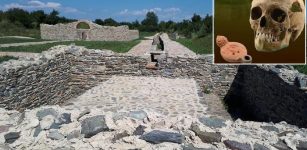On This Day In History: Edict Of Pistres ‘A New Law’ Against Viking Raids Issued – On July 25, 864
Ancient Pages.com - On 25 July 864, the Edict of Pistres 'a new law' was publicly made known.
Historians often cite it as one of the rare examples of successful government action on the part of Charles the Bald, King of West Francia (823 -877) and also King of Italy (875-77) and Holy Roman Emperor (875-77, as Charles II).
Charles the Bald as depicted in the Vivian Bible, c. 845. Comte Vivien - Public Domain
At the time, Vikings were very troublesome and, more than annually, attacked not only the Frankish coastlands but, with the aid of Europe's several navigable rivers and much of the country's interior.
A king was most valued who could defeat them in the field and prevent their attacks in the future. The purpose and primary effect of the Edict of Pistres was long thought to protect the cities and countryside from Viking raids.
Charles created a large force of cavalry upon which he could call as needed. He ordered all men who had horses or could afford horses to serve in the army as cavalrymen.
It was one of the beginnings of the French chivalry so famous for the next seven centuries. Charles intended to have a mobile force descend upon the raiders before they could up and leave with their booty. Charles also declared that fortified bridges should be built at all towns on rivers to prevent the Vikings from even attaining a great booty.
It was to prevent the Vikings' longships from sailing into the interior. Charles also prohibited all trade in weapons with the Vikings, preventing them from establishing bases in Gaul. The penalty for selling horses to the Vikings was death.
Since the prohibition on the sale of horses was new, mounted Viking raids were probably on the rise. The Edict of Pistres also had political and economic consequences. Economically, besides prohibiting commerce with the enemy, Charles tightened his control of the mints and regulated the punishment for counterfeiting.
Before this proclamation, at least nine places in France had the right of minting, but these were reduced to three.
Charles also attempted to control the building of private castles, but this failed. Even minor lords constructed fortresses on local hilltops to defend themselves and their peasants from the constant threat of Scandinavian invasion.
AncientPages.com





















